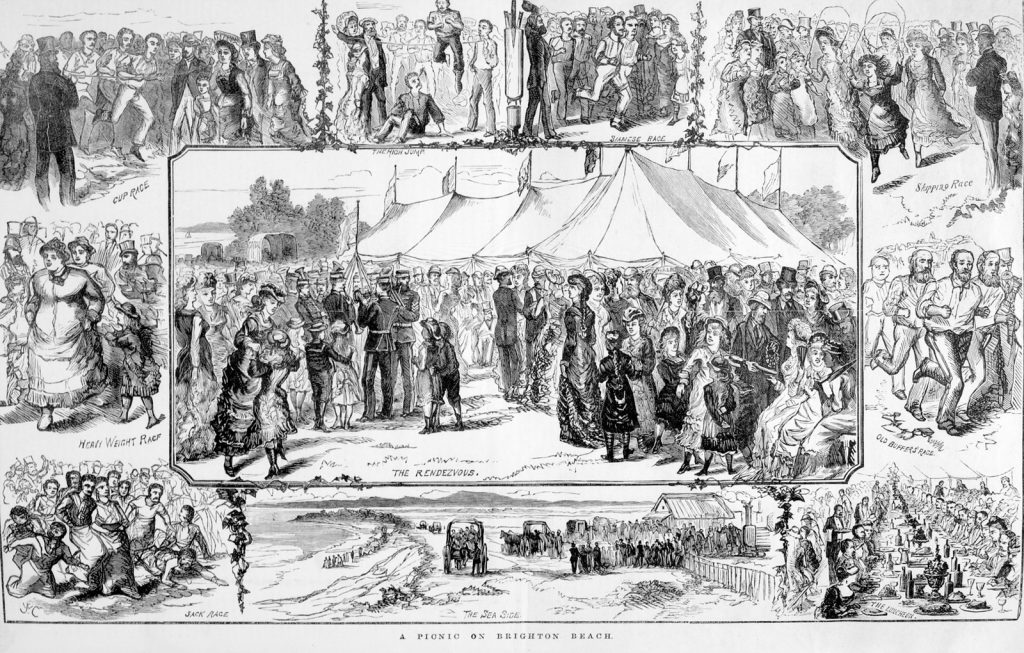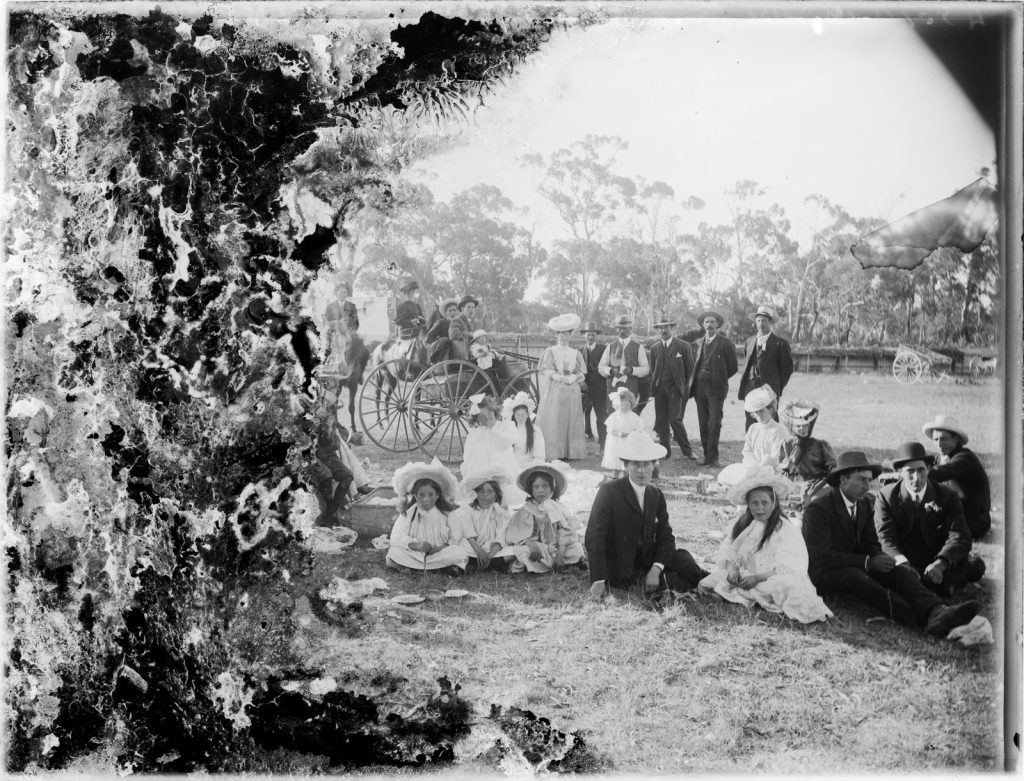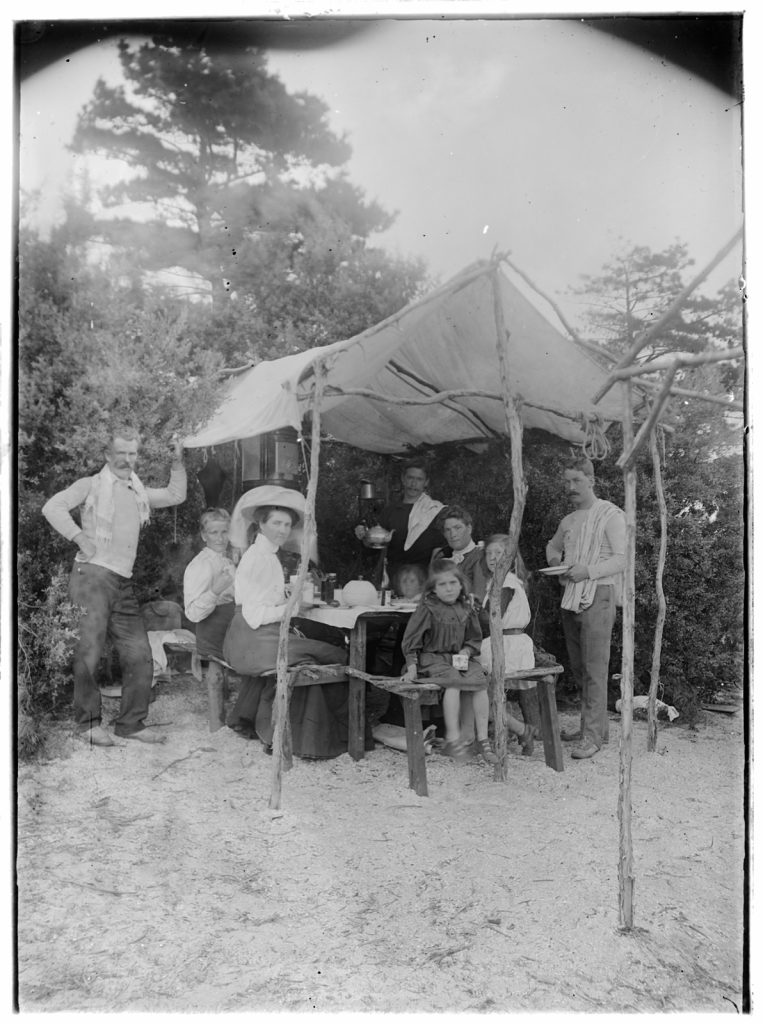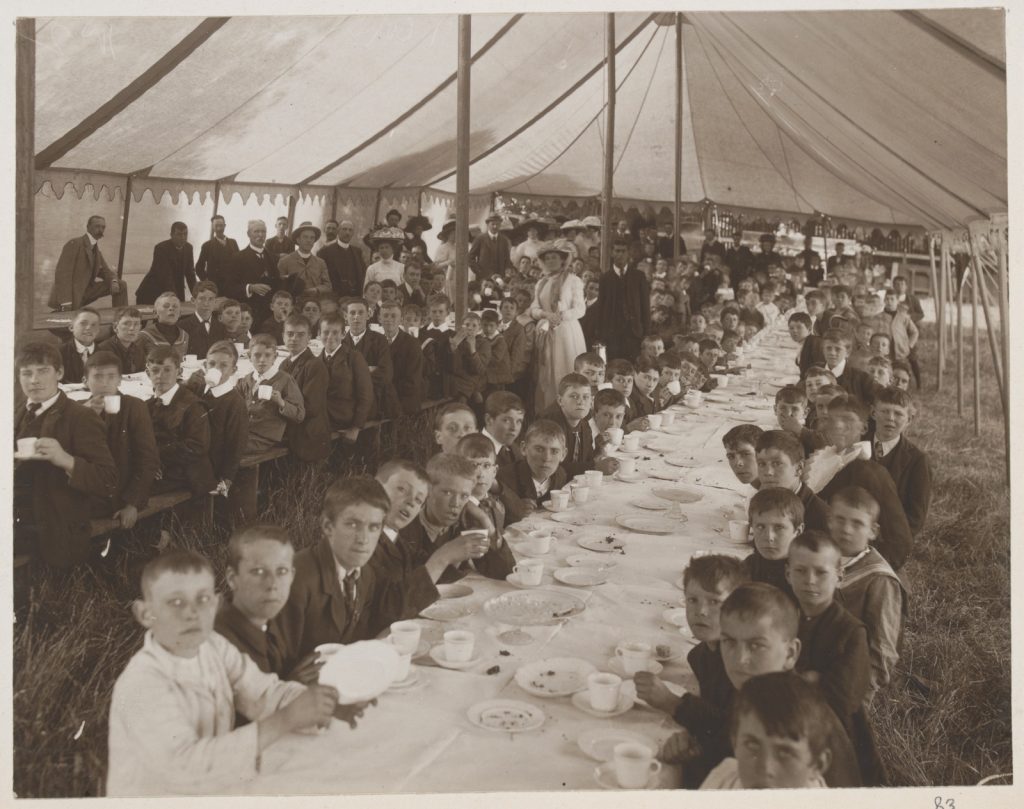
Who doesn’t love a picnic? Victorians’ love of picnics dates back to the nineteenth century: family picnics and picnics shared with fellow workers or members of a local organisation. Despite the challenges of slow horse-drawn transport, little protection from the weather and no refrigeration, Victorians were determined to enjoy the great outdoors.
In the 1850s, Melbourne land sale auctions were often accompanied by picnics or ‘fetes’, as they were known. Expecting free food and drink, one disgruntled attendee voiced his disappointment in verse:
Am sick of the pic-nic today
‘Twas a hoax, there can be no dispute…
This grand fete was a palpable dodge,
No free lunch and no sparkling champagne…
For my thirst I was forced to assuage
At the creek, ‘pon my word it’s the truth…
A pic-nic! What pleasure untold,
Is implied by that popular word,
But alas, we poor fellows were sold,
Who couldn’t a nobbler afford… 1
(Melbourne Punch, 14 April 1859).
Outdoor activities were part of the fun in nineteenth century picnics: bag races, skipping races, tug-of-war, races for married men and for married women, races for ‘heavyweights’ and even races for ‘old buffers’: men aged over 40.

Some picnics were grand affairs. In December 1859, the Golden Lodge of Bendigo (the Masons), celebrated the Festival of St. John at Emu Creek in elaborate fashion: twenty-five carriages, with other members on horseback and the Tourist Band made their way to Emu Creek, where a giant marquee, 80 feet (24 metres) long, was erected. Around 150 people attended. While the band played, visitors danced the valse, the polka and the quadrille. The ladies, wearing colourful costumes, played games such as les graces 2. The gentlemen played cricket, trap ball and hockey. A quiet lounge was provided for the less energetic. Dinner comprised well-cooked cold joints of various meats, washed down with drinks ranging from ginger beer to imperial champagne. (Bendigo Advertiser, 30 December 1859)

In her 1897 book, Australian table dainties and appetising dishes 3 Harriet Wicken’s picnic suggestions included cold beef pies, cold chicken pies and rolls, savoury pies, Strasbourg meat sandwiches, pressed beef with salad, cheese and mustard sandwiches, and cheese pastry. Lighter fare included stewed apple puffs, honey cakes, scones and seed biscuits.

People from diverse occupations celebrated events and festivals through annual picnics: farmers, dairymen, the Masons, stevedores, seamen, butchers, brewers, brickmakers, bakers, foresters, bookmakers, tailors and Tramways employees. ‘Theatrical’ people, church and business groups, blind groups and the Young Men’s Association all had their picnics.
Employees of the Brewers and Cordial Manufacturers of Sandhurst (now Bendigo) and District, enjoyed a picnic at Bridgewater in April 1888. A special train transported the participants to a picturesque spot near the Loddon river, where they enjoyed rowing and games. The organised sports were not regarded as a success, attracting few brewery workers. Some of the events do look like hard work: a cask trundling handicap of 100 yards (91 metres); a hurdle race of 100 yards; a cordial tying competition, with a limit of 4 dozen soda bottles, and a wire tying competition, champagne style. Perhaps the races reminded the workers of their daily tasks! Foot races featured, not least the ‘Old Buffers race’. (Bendigo Advertiser,19 April 1888)

A ‘religious’ picnic at Brighton Beach, organised by a Mr Varley in 1877, was aimed at luring the public away from the races. Around 10,000 visitors attended, enjoying beach strolls and quiet talks, interspersed with religious services. It was thought that many were attracted by the food and others were family beachgoers. (The Argus, 7 November 1877 )
A ‘monster’ railway picnic to Queenscliff in 1884 was designed to bring different social groups into contact and widen the knowledge of all. It included a visit to the seashore to collect seashells and view the lighthouses, combined with a guided tour around the gun batteries, with young artillerymen explaining the working of the guns. The local militia performed drill movements at the fort, flags flew, a band played, visitors danced on the green and there were the usual races. The picnic goers finished with singing, ‘fun and frolic’ as they returned home by train. (Queenscliff Sentinel, 1 November 1884)


The popularity of picnics continued into the twentieth century.
Melbourne’s newsboys had an annual picnic, organised by the City Newsboys’ Society and funded by public donation. The picnic was a thank you to the boys who sold newspapers in all weathers in Melbourne’s streets to help support their impoverished families. Their picnics were held in many different locations. In 1888, the boys enjoyed a picnic at Halfmoon Bay (The Elsternwick Leader and District Record, 21 January 1888) and in 1911, 250 ‘merry city newsboys’ and their friends travelled to Rye on the Lady Loch, the government steamer, singing comic songs along the way. (Weekly Times, 4 March 1911)
In 1909 the City Newsboys’ Society picnic was held at the State Governor’s residence, Stonington, in Malvern. Arriving at 2.30 pm, the boys, ‘agog with excitement and happiness’ ran down the hill to the merry-go-round and the ‘snowy’ marquees. They ran races to the sound of wailing bagpipes and were presented with prizes from their studies at the newsboys’ school. Afterwards, the Governor, Sir Thomas Carmichael and Lady Carmichael served the boys tea, cake and other tasty goodies. (The Age, 13 December 1909)

Picnics have always been popular in Victoria. We have the images to prove it! A search of our online catalogue gives you free access to over 1600 photos and engravings of picnics, ranging from the nineteenth century up to today.
To find our picnics pictures, just go to our catalogue and type in the word picnic, selecting the Pictures & Photographs option on the drop-down menu. Click the magnifying glass icon to search. To find historic images, you can sort the results by oldest date first, and you can limit the dates of the images under the Creation Date option. You can zoom into the online images, download and print. Happy picnicking!
You may also like
References
- Nobbler: any small glass of spirits. ‘Nobbler’, 2023, in Macquarie Dictionary. Viewed 10 February 2023
- Jane Austen Centre, n.d., The Game of Graces, viewed 10 February 2023, <https://janeausten.co.uk/blogs/home-and-hearth/the-game-graces>
- Wicken, HF, 1897, Australian table dainties and appetising dishes : a handy guide for Australian housekeepers in the preparation of fruit, vegetables, game, fish, salads, sweets, and the picnic basket : including recipes for the invalid’s corner, lenten fare and Christmas dainties, Ward, Lock, London, Melbourne.


So good hope all dates are circa right. Dress fashions help with detail in photos I have.